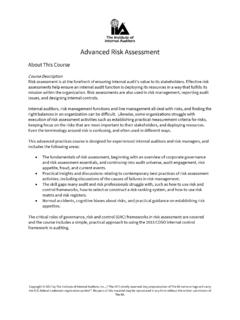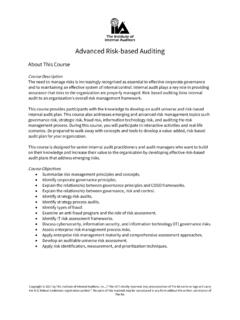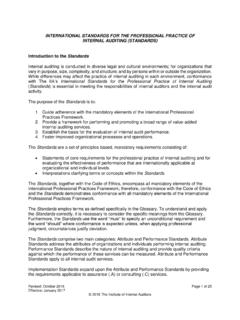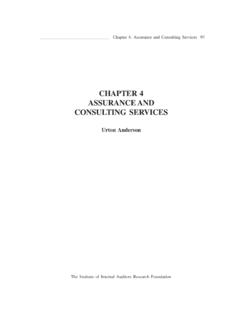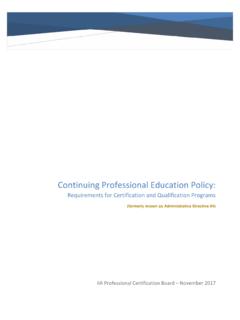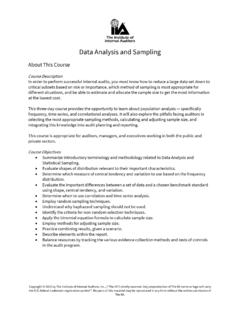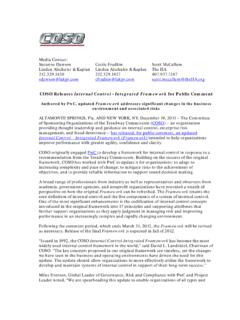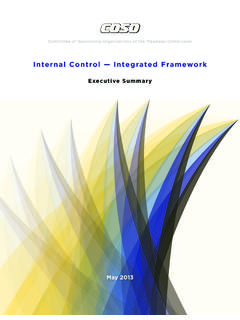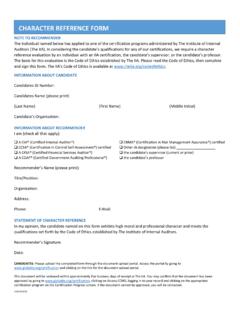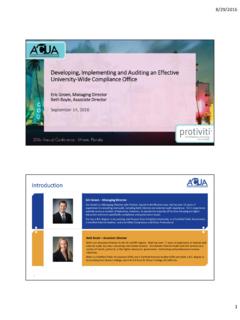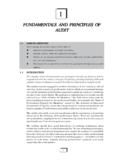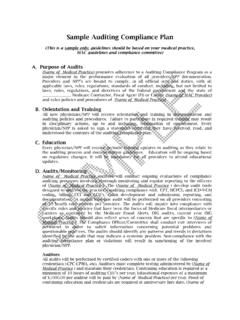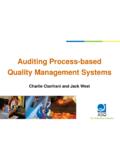Transcription of Performing an Effective Quality Assessment
1 Copyright 2017 by The Institute of Internal Auditors, Inc., ( The IIA ) strictly reserved. Any preproduction of The IIA name or logo will carry the federal trademark registration symbol . No parts of this material may be reproduced in any form without the written permission of The IIA. Performing an Effective Quality Assessment About This Course Course Description As an organization grows and its internal processes change and evolve, its Quality monitoring process must keep pace. To ensure consistent Quality in this dynamic environment, an ongoing commitment to growth and improvement is essential. The required elements of a Quality Assurance and Improvement Program (QAIP) include periodic internal assessments and external assessments to demonstrate conformance with The IIA s International Standards for the Professional Practice of Internal Auditing.
2 In addition, a Quality QAIP can provide evidence to the audit committee and management that the internal audit activity is efficient, Effective , and adding value. It can also build stakeholder confidence and document a commitment to Quality , leading practices, and the internal auditors mindset for professionalism. This course will provide you with the appropriate knowledge and skills to plan, perform, and evaluate the results of an external Quality Assessment case study. You will also learn about the processes and tools in the IIA Quality Assessment Manual (QA Manual) that can help you identify opportunities to improve your internal audit Quality activities. Course Objectives Examine the process flow and tools in the updated QA Manual and explore how these can be used to evaluate conformance with the Standards and identify opportunities for continuous improvement.
3 Practice using the QA Manual tools to plan, perform, and evaluate the results of an external Quality Assessment case study. Discuss how to use the QA Manual tools in a periodic self- Assessment . Evaluate the external Quality Assessment options and determine which option will work best for your internal audit activity. Copyright 2017 by The Institute of Internal Auditors, Inc., ( The IIA ) strictly reserved. Any preproduction of The IIA name or logo will carry the federal trademark registration symbol . No parts of this material may be reproduced in any form without the written permission of The IIA. Course Topics Quality Manual and Process Overview The International Professional Practices Framework (IPPF) The QAIP Framework Overview of the Quality Assessment Manual (QA Manual) and its process flow and tools Types of internal audit Quality assessments Planning the Quality Assessment Quality Assessment scope, objectives, and planning tools Key features of planning guides Case study Successful practices, opportunities for improvement, and planning the work Key features of surveys Case study survey results Performing the Quality Assessment Key features of interview guides (key practices and lessons learned)
4 Case study interview results Key features of QA programs and supporting tools Case study Quality Assessment program results Evaluating Quality Assessment Results QA Manual evaluation summary tools and Assessment criteria Applying Assessment criteria on common QA scenarios (that require a high level of professional judgment) Evaluating case study results, using the Assessment criteria Key features of the QA Manual reporting tools Value-added solutions for the most significant case study opportunities for improvement Periodic Self- Assessment Application Implications of the relevant IPPF guidance Applying the IPPF Implementation Guides and QA Manual to common periodic self- Assessment scenarios External Quality Assessment Options Implications of the relevant IPPF guidance External QA options, and the related pros, cons.
5 And other considerations Applying the IPPF Implementation Guides and your business acumen to common external Quality Assessment scenarios How to prepare for an external Quality Assessment Copyright 2017 by The Institute of Internal Auditors, Inc., ( The IIA ) strictly reserved. Any preproduction of The IIA name or logo will carry the federal trademark registration symbol . No parts of this material may be reproduced in any form without the written permission of The IIA. Course Information Course Duration: 2 Days CPE Hours Available: 16 Knowledge Level: Intermediate Field of Study: Auditing Prerequisites: Participants should have 3 5 years experience in internal audit. Advance Preparation: None Delivery Format: eLearning (Group-Internet-Based); On-site Training (Group-Live); Seminar (Group-Live)
